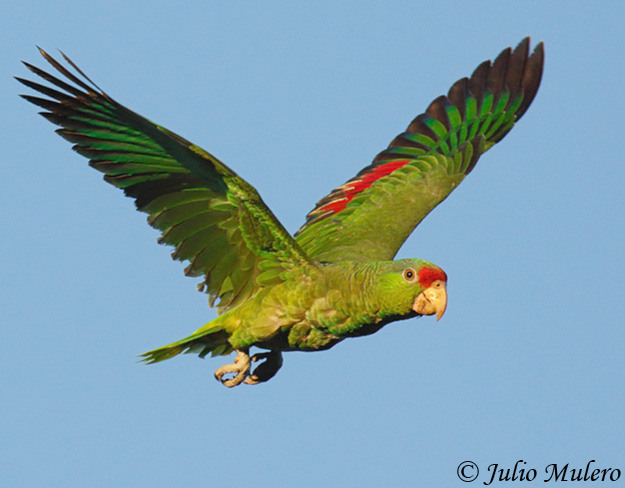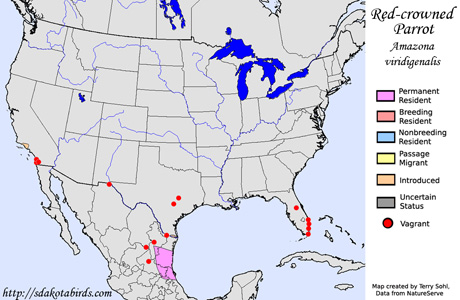| Length: 12-13 inches | Wingspan: 18-20 inches | Seasonality: Non-resident in South Dakota |
| ID Keys: Green overall, with bright red forehead, dull purplish-blue band from above eye down back of neck, 5 red secondary flight feathers (see photo below) | ||
 The
Red-crowned Parrot is a native of eastern Mexico where they are found in
canyon forests. They are also known locally as the "Green-cheeked
Amazon", "Red-crowned Amazon", or "Red-headed Parrot". They are not
native in the United States, but because sustainable breeding populations
have now been established in several locations, the American Birding
Association now includes the Red-crowned Parrot on it's official checklist
of North American birds (U.S. and Canada area). Released cage birds
have become established into sizable breeding populations in several large
cities. The Los Angeles area, San Diego, and Miami all have populations that
are self-sustaining. A stable resident population has also become
established in the Rio Grande Valley along the U.S. and Mexico border.
The provenance of the Rio Grande population is in dispute, with some
believing it originated from wild birds that moved northward from eastern
Mexico, while others believed that escaped cage birds initiated the breeding
population. Ironically, as Red-crowned Parrots become well-established in
several locations in the United States, they are seriously endangered in
their native Mexico.
It is now likely that there are more Red-crowned Parrots living outside of
their native range in the U.S. than in Mexico. Populations have
now also become established in Puerto Rico and Oahu in Hawaii.
The
Red-crowned Parrot is a native of eastern Mexico where they are found in
canyon forests. They are also known locally as the "Green-cheeked
Amazon", "Red-crowned Amazon", or "Red-headed Parrot". They are not
native in the United States, but because sustainable breeding populations
have now been established in several locations, the American Birding
Association now includes the Red-crowned Parrot on it's official checklist
of North American birds (U.S. and Canada area). Released cage birds
have become established into sizable breeding populations in several large
cities. The Los Angeles area, San Diego, and Miami all have populations that
are self-sustaining. A stable resident population has also become
established in the Rio Grande Valley along the U.S. and Mexico border.
The provenance of the Rio Grande population is in dispute, with some
believing it originated from wild birds that moved northward from eastern
Mexico, while others believed that escaped cage birds initiated the breeding
population. Ironically, as Red-crowned Parrots become well-established in
several locations in the United States, they are seriously endangered in
their native Mexico.
It is now likely that there are more Red-crowned Parrots living outside of
their native range in the U.S. than in Mexico. Populations have
now also become established in Puerto Rico and Oahu in Hawaii.
Controversy exists over the status of the birds in the United States. If indeed the population in the Rio Grande Valley was established naturally from wild migrants, the species is eligible to be protected under the Endangered Species Act. While conservationists interested in the survival of the species support such a move, land owners in the region oppose the listing, as it would potentially result in land-use provisions imposed in the Rio Grande. Those who keep Red-crowned Parrots as pets also oppose the move, as having them listed as threatened or endangered would result in interstate transfer laws affecting movement of pet birds.
Habitat: In their urban and suburban settings in the United States (e.g., Los Angeles, San Diego), they are typically found in older settings with well-established landscaping of exotic trees and shrubs. In their native range in Mexico, they are found on rugged forested slopes, and sometimes in agricultural areas with scattered trees.
Diet: Adaptable, and can feed on a variety of food items depending upon location and what's available. Favored foods include fruits and berries, flowers and nectar, nuts, acorns, seeds, and agricultural grain products. In its native range in Mexico, the traditional food was native fruits.
Behavior: Usually gregarious, found in loose breeding colonies, and forming larger foraging flocks outside of the breeding season.
Nesting: The nest of a Red-crowned Parrot is in a cavity of a tree. The female lays 2 to 5 eggs, and she alone incubates them while the male delivers food during the incubation period. The eggs hatch after about 4 weeks.
Song: The most common call is a shrill, ascending series of notes. Also has raspy cackles and other vocalizations.
Migration: Considered a permanent resident in their normal range. However, they are somewhat nomadic outside of the breeding season, moving about in foraging flocks in search of fruits and other foraging opportunities.
Interactive eBird map: Click here to access an interactive eBird map of Red-crowned Parrot sightings
Similar Species: Similar in overall appearance to the Thick-billed Parrot, a species that was actually once one of two parrot species (along with the now extinct Carolina Parakeet) that was native to the United States. The Thick-billed Parrot was once found in Arizona and New Mexico, but is now only found in Mexico. It's thus unlikely that a birder would have to differentiate between a Thick-billed Parrot and Red-crowned Parrot in the United States. In terms of appearance, both are green overall with a red forehead. The Red-crowned Parrot has less red on the head, including a lack of the red eyebrow found on the Thick-billed Parrot. The Thick-billed Parrot also has a red shoulder patch that's lacking on the Red-crowned Parrot.
Conservation Status: The IUCN lists the Red-crowned Parrot as "Endangered". Loss of forest habitat is undoubtedly the major cause of the decline in their native Mexico. Additional threats include persecution (aka, "shooting") of Red-crowned Parrots that are deemed to be agricultural pests, and capture of wild birds for sale in the illegal pet trade.
Further Information: 1) WhatBird - Red-crowned Parrot
2) BirdLife International - Red-crowned Parrot
3) The California Parrot Project - Red-crowned Parrot
Photo Information: Photo by Julio Mulero - Photo licensed under Creative Commons Attribution NonCommercial NoDerivs 2.0 Generic License
| Click below for a higher-resolution map |
 |
| South Dakota Status: Non-resident in South Dakota |
Additional Red-crowned Parrot Photos (coming soon!!)
